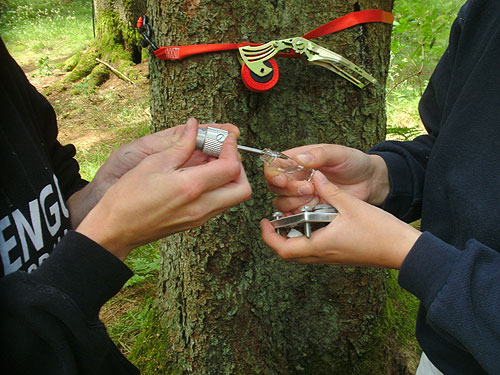| Picture: Microcore sampling from a Norway spruce tree in the Wüstebach catchment, Eifel National Park. © Neuwirth 2018 |
Event dates: two weeks in September/October 2018 (10.-14.09.2018 and 15.-19.10.2018)
Event location: Eifel National Park (sampling) and Dendro Labor Windeck (sample preparation and analysis)
Author name: Inken Rabbel
Author project: Analyzing feedbacks in a forest soil-vegetation-atmosphere system
Author position: PhD student in C1
Author institute: Department of Geography, University of Bonn
Within the TR32 and for my PhD project, we have used dendrometers to monitor intra-annual growing patterns of different tree species over years. One current challenge in dendroecology is to put such short-term observations into context with long-term inter-annual growth variations as obtained from tree ring data. A possibility to close the gap between the high resolution dendrometer data and the annually-resolved tree ring data is the analysis of actual cell growth in intermediate time steps. To this end, small samples of wood (microcores) need to be taken from the developing current year tree ring in bi-weekly or shorter time steps. On the basis of the resulting intra-seasonal microcore chronology, tree rings can be resolved intra-annually and actual cell growth can be related to the shape of the dendrometer curve
For a pilot study during the heat summer 2018, we took microcores of three Norway spruce trees in weekly time steps by using a so-called puncher (see picture). At the same time, the trees were equipped with dendrometers. To learn how to prepare and analyse our microcores, I attended a respective training course at the Tree-Ring Lab in Windeck (DeLaWi-Jahrringanalytik).
After the field campaign, we first fixed our samples on small wooden bars that help to clamp the microcore into a so-called microtome. With the microtome we cut thin sections of 10-30 µm from our microcores. These thin sections were transferred to glass carriers, where we stained them to allow for the visual separation of living tissue and actual heartwood cells. After various bleaching procedures, the thin sections were embedded in resin (Canada balsam) and covered with a cover glass avoiding the enclosure of air bubbles. Finally, the slides were dried in an oven. After completing this preparation procedure, we examined our samples under the microscope.
The training course provided valuable insights into the field techniques of microcore sampling and the processing of respectivethin sections. The preparation procedure is very complex and certainly needs some training and routine. Based on the gained experience I hope to be able to process further thin sections of microcores on my own and I am confident that combining our microcore chronology with the dendrometer data of the heat summer 2018 will provide sufficient material for publication.











